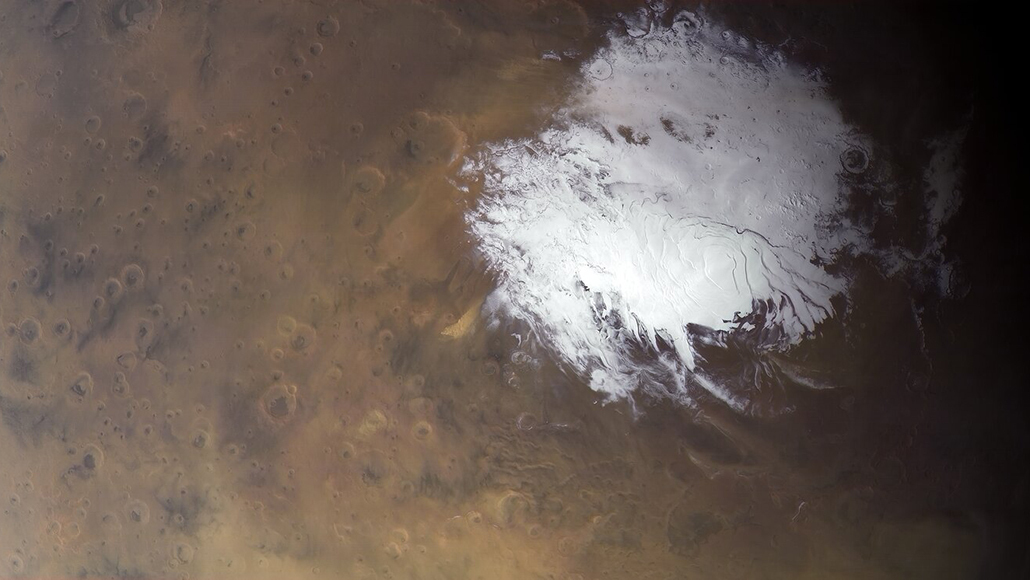
New radar data from the Mars Express orbiter suggests that a possible lake 1.5 kilometers under the ice at Mars’ south pole (shown) is surrounded by pools of liquid water.
J. Cowart/FU Berlin/DLR/ESA (CC BY-SA 3.0)
- More than 2 years ago
Fresh intel from Mars is sure to stir debate about whether liquid water lurks beneath the planet’s polar ice.
New data from a probe orbiting Mars appear to bolster a claim from 2018 that a lake sits roughly 1.5 kilometers beneath ice near the south pole (SN: 8/18/18). An analysis of the additional data, by some of the same researchers who reported the lake’s discovery, also hint at several more pools encircling the main reservoir, a study released online September 28 in Nature Astronomy claims.
If it exists, the central lake spans roughly 600 square kilometers. To keep from freezing, the water would have to be extremely salty, possibly making it similar to subglacial lakes in Antarctica. “This area is the closest thing to ‘habitable’ on Mars that has been found so far,” says Roberto Orosei, a planetary scientist at the National Institute for Astrophysics in Bologna, Italy, who also led the 2018 report.
Ali Bramson, a planetary scientist at Purdue University in West Lafayette, Ind., agrees “something funky is going on at this location.” But, she says, “there are some limitations to the instrument and the data…. I don’t know if it’s totally a slam dunk yet.”
Orosei and colleagues probed the ice using radar on board the European Space Agency’s Mars Express orbiter. Short bursts of radio waves reflect off the ice, but some penetrate deeper and bounce off the bottom of the ice, sending back a second echo. The brightness and sharpness of that second reflection can reveal details about the underlying terrain.
The possible lake was originally found using radar data collected from May 2012 to December 2015. Now, in data collected from 2010 to 2019, the team once again found regions beneath the ice that are highly reflective and very flat. They say their findings not only confirm earlier hints of a large buried lake but also unearth a handful of smaller ponds encircling the main body of water and separated by strips of dry land.
“On Earth, there would be no debate” that a bright, flat radar reflection would be liquid water, Orosei says. These same analysis techniques have been used closer to home to map subglacial lakes in Antarctica and Greenland.
While much about these putative ponds remains unknown, one thing is certain: This new report is bound to spark controversy. “The community is very polarized,” says Isaac Smith, a planetary scientist with the Planetary Science Institute who is based in Ontario, Canada. “I’m in the camp that leans towards believing it,” he adds. “They’ve done their homework.”
One question centers on how water could stay liquid. “There’s no way to get liquid water warm enough even with throwing in a bunch of salts,” says planetary scientist Michael Sori, also at Purdue.
In 2019, he and Bramson calculated that the ice temperature — about –70° Celsius — is too cold even for salts to melt. They argue some local source of geothermal heat is needed, such as a magma chamber beneath the surface, to maintain a lake. That in turn has led to other questions about whether contemporary Mars could supply the necessary heat.
Smith — as well as the paper’s authors — thinks this isn’t a problem. As recently as 50,000 years ago, Smith says, the Martian south pole was warmer because the planet’s tilt (and hence its seasons) is constantly changing. Warmer temperatures could have propagated through the ice to create pockets of salty liquid. Alternatively, the ponds may have been there before the ice cap formed. Either way, at very high salt concentrations, once water has melted, it’s hard to get it to freeze again. “The melting temperature is different than the freezing temperature,” he says.
Even so, such liquid may be unlike any that most earthlings are familiar with. “Some supercooled brines at these cold temperatures are still considered liquid but turn into some weird glass,” Bramson says.
Resolving these questions will probably require more than radar. Multiple factors, such as the composition and physical properties of the ice, can alter the fate of the second echo from the bottom of the ice, says Bramson. Seismology, gravity and topography data could go a long way to revealing what lurks beneath the ice.
Whether anything could survive in such water is an open question. “We don’t know exactly what is in this water,” Orosei says. “We don’t know the concentration of salts, which could be deadly to life.” But if life did evolve on Mars, he speculates, “these lakes could have been providing a Noah’s Ark that could have allowed life to survive even in present conditions.“







